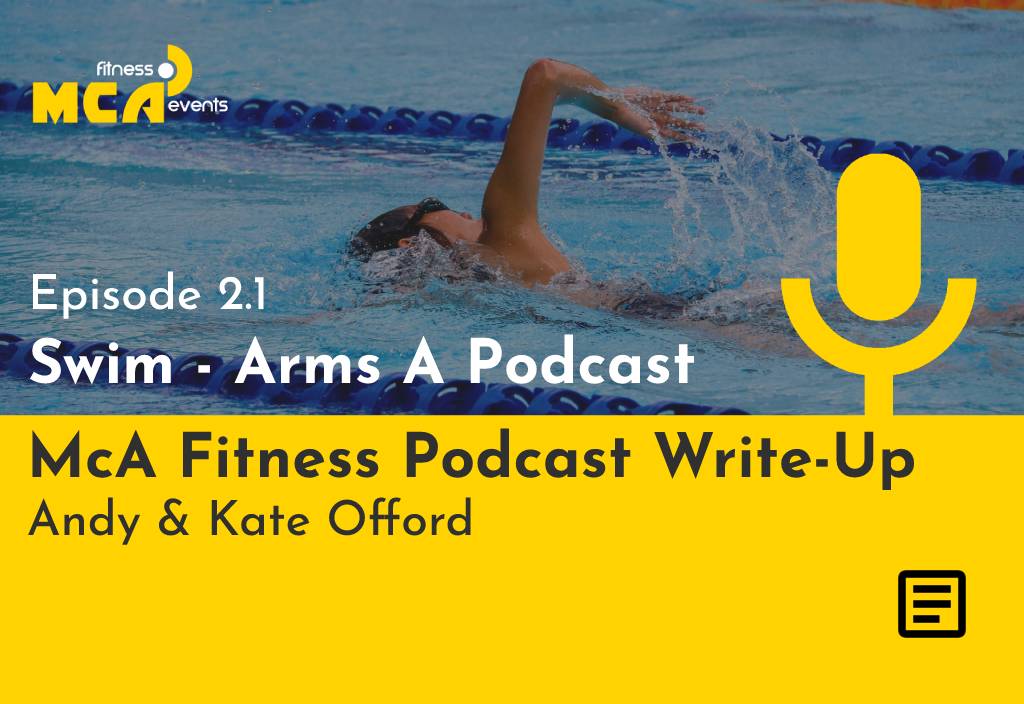Here we go with our third Podcast for you to enjoy. It’s actually the second in our Swim series but who’s counting? Sit back. grab a cup of tea (or isotonic drink of some description) and enjoy
Catch the full recording of this podcast or just read our edited transcription below.
KATE: Hi Im Kate from Smiling Tri Coach
ANDY: On this episode Kate will be talking us through terms related to your swimming arms.
ANDY: Starting with catch
KATE: Catch is really really important in swimming. What catch refers to is how your hand enters the water and then gets hold of that water and pushes it behind you to enable you to move forward.
KATE: The way I always think about catch is when people are windmilling and their arms are going really quickly yet they don’t seem to be going anywhere. It’s because they are not catching the water properly.
KATE: If you think about actually trying to pull your body over your arm rather than pulling your arm under your body then that’s a really helpful way to try and visualise the catch.
KATE: If you were to speer into the water with your hand and put your fingertips on the rung of a ladder (if you can imagine a ladder underneath you) and then pull your body over the ladder then you’re making physical progress forward your not just moving your arm under your body.
KATE: When people talk about feel in swimming and how swimmers feel the water they are talking about the catch. So as your hand enters you get hold of the water quite quickly and really move the water behind you which then prepels you forwards.
ANDY: Pull
KATE: Pull in swimming refers to just using the upper body and putting a pull buoy between the tops of your legs.
KATE: When you have a pull buoy in its best to keep your toes pointed and it will pull your legs up and you can focus on your upper body rotation, the catch and the pull.
KATE: It’s strength building but it’s also because you’re taking legs out of the equation you work more in kind of a zone 2 or an aerobic zone where you’re not getting too out of breath because you’re not using those big muscles in your legs.
KATE: You might find as a Triathlete that you can swim further for longer when you’re pulling as you’re taking your legs out than you can when you suddenly add your legs back in.
KATE: It’s a really good way of building base fitness for swimming.
ANDY: Paddles
KATE: Now hand paddles are loved by Triathletes across the land. They are plastic pads with little bits of elastic that hold your fingers in and you can get all different types of paddles. Some will work on your technique and some will just give you a little resistance.
KATE: Paddles are a great aid to use along with your pull buoy because you’re isolating your legs and taking them out of the stroke so are just using your upper body.
KATE: It basically becomes a form of resistance training so if you want to enhance the resistance element of your work and the strength element of your training then paddles are really great.
KATE: They also try to ensure that you are getting your hand entry in a better position, more sort of technically correct. As you pull back because of the nature of the classic surface area of the paddle they ensure that you are pulling the water back in the right planes so your technique improves over time.
KATE: Just a word of warning. In terms of injury prevention if you suddenly go from never using paddles to using them all the time you can risk shoulder injuries like overuse. so just use them with caution and build into use of them.
ANDY: Thanks Kate.
If you missed our previous podcast that started our Swim series then just click the link. Otherwise we hope you enjoyed this one and will check back soon for our next swim post.
Don’t forget to check out our events page for all our latest events. There’s sure to be something that is right up your street.

